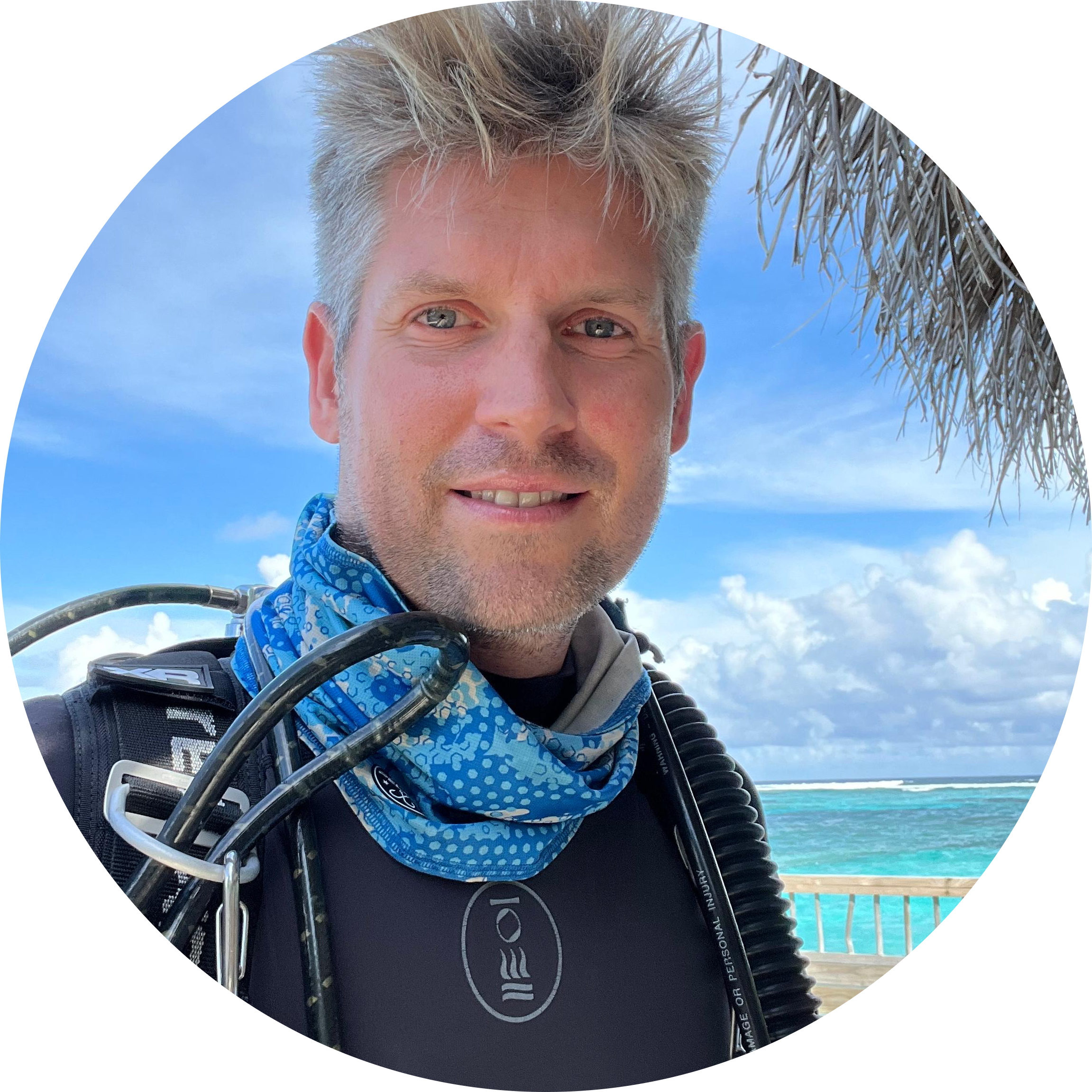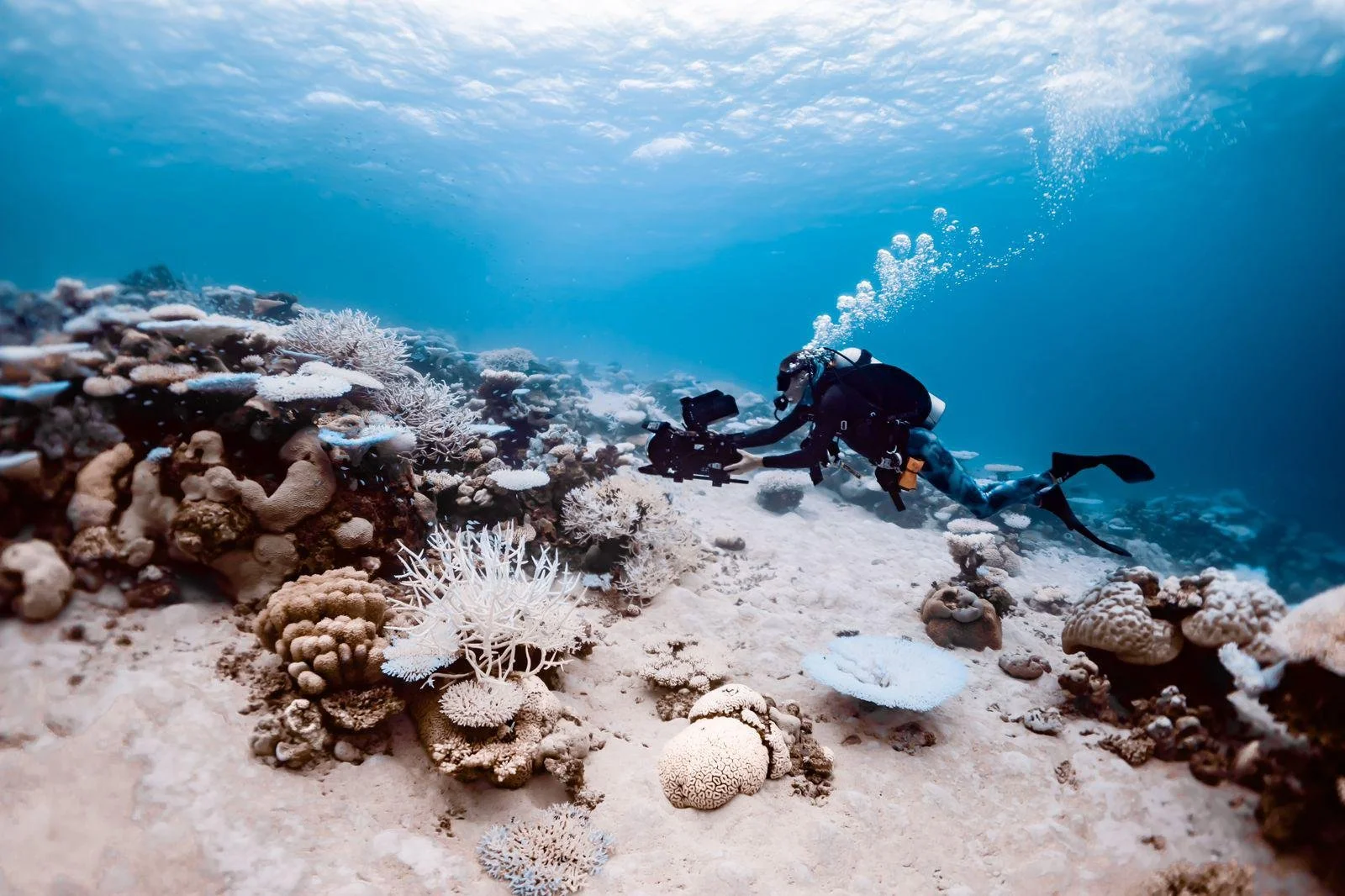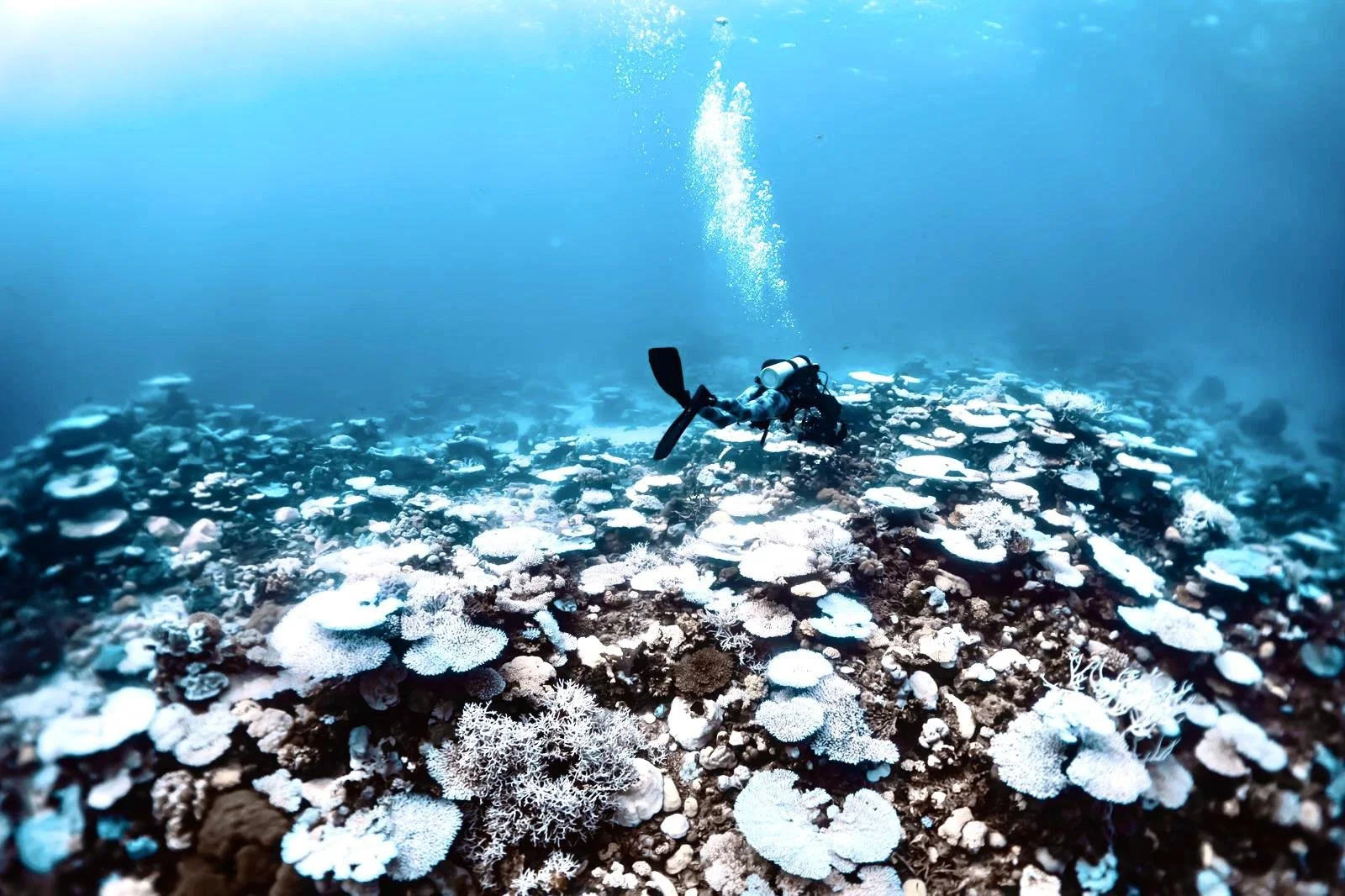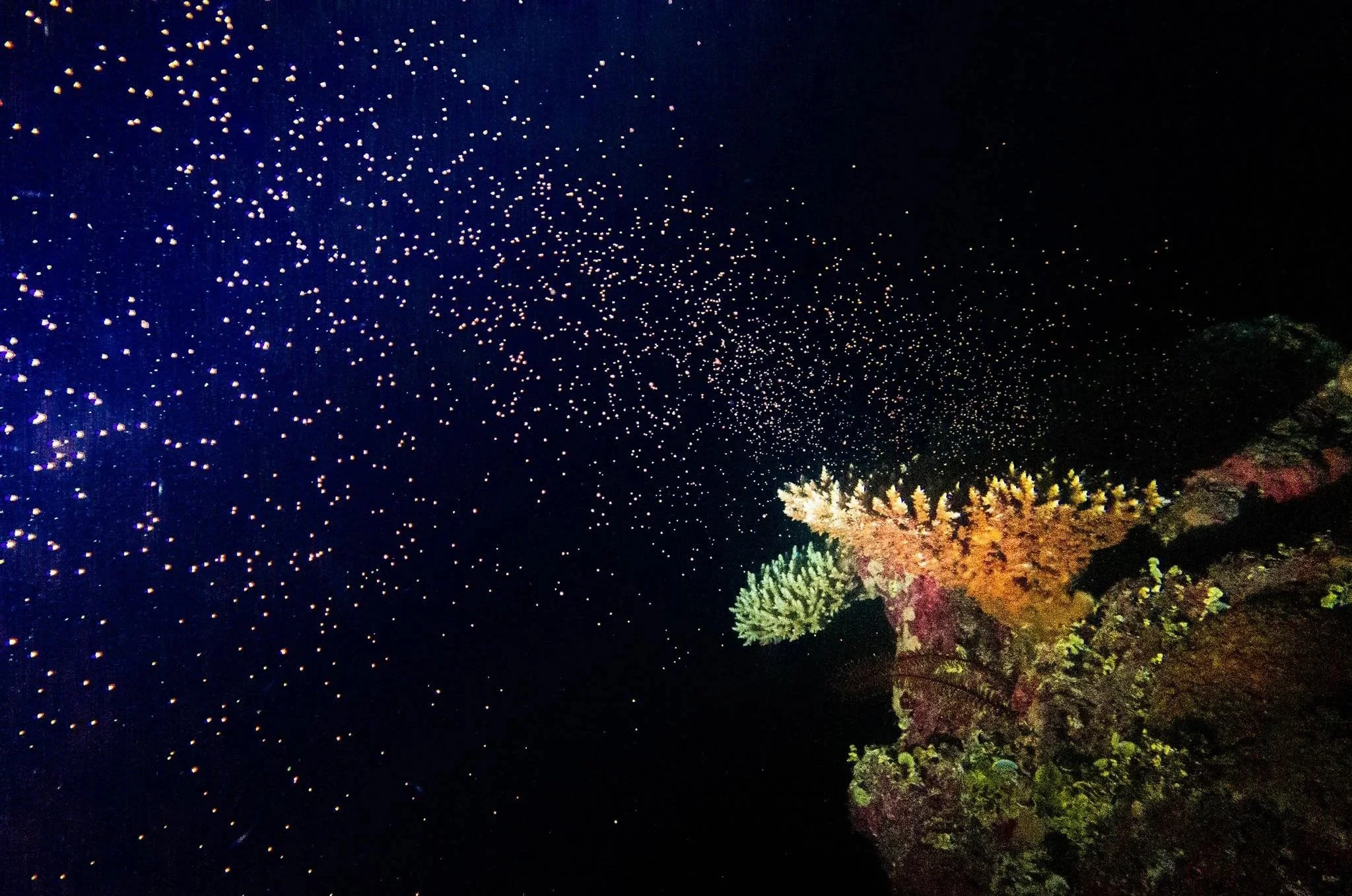SPECIAL INTERVIEW WITH CINEMATOGRAPHER MARK SHARMAN
MARK SHARMAN
Award-winning cinematographer specializing in filming wildlife and people in marine environments
This month, we're thrilled to feature a special guest blog from acclaimed underwater cinematographer Mark Sharman, whose striking footage of the 2024 coral bleaching in Laamu Atoll has been featured in the new global documentary ‘Ocean’, narrated by Sir David Attenborough. Mark has visited Laamu several times, collaborating with the Maldives Underwater Initiative (MUI) to tell our team’s research stories, as well as to document marine life, including the challenging times for our coral reefs. In this Q&A, we explore Mark's perspective on filming vulnerable ecosystems, his connection to the Maldives, and the power of visual storytelling in marine conservation.
Mark, tell us a bit about yourself. What led you to become an underwater cinematographer?
I grew up loving watching wildlife documentaries narrated by David Attenborough and this transformed into an interest and love for filming and making videos and studying film and TV production at college and University. I was a competitive swimmer growing up too, so always loved being in the water and pushing my limits. The underwater world really captured my imagination in books and TV programmes, so scuba diving was the next step after swimming and I put all my interests together and went on a mission to turn my combination of interests into a career, and I haven’t looked back!
You've filmed all over the world—what makes Laamu Atoll special to you?
I’ve been lucky to forge a career in this field for the past 20 years, and it’s taken me all over the world, filming in some of the world’s best dive locations. The Laamu Atoll in the Maldives is special as it’s a place I’ve been able to enjoy with my family too, which has been a rare thing. I’ve been able to begin sharing what I love about the ocean with my two children and wife, whose first scuba dives were at Six Senses Laamu. I’ve been lucky enough to spend multiple trips diving on the reefs around Laamu, so I feel like I’ve got to know the area much more than other places I’ve visited.
Can you describe the moment you first witnessed coral bleaching in Laamu? What were you feeling as you filmed it?
My trip to Laamu in May 2024 was to base the trip around filming the bleached corals of the area. This was heartbreaking to witness first hand, these magnificent unspoiled reefs suffering in the latest El Niño event, which caused a wave of warm sea temperatures to come through, stressing the corals and ultimately ending many of their life. Only a few months prior to this, I’d seen and filmed these reefs in pristine condition, so it was shocking to see how quickly things can change. Luckily not all corals were affected by the bleaching event. I purposefully travelled to the worse hit areas, to show the worse of the impact and I am glad to hear from the team, that some of the reefs that I filmed are recovering.
Mark filming the global bleaching event in 2024. Photo by Miriam Staiger.
Your footage has reached a global audience through Ocean. Why do you think it's important for people to see these changes?
There was a time in the industry, not too long ago, that environmental and human impact issues were generally avoided in wildlife documentaries. The commissioners didn’t think the audience would want to see ‘bad news’, and just want escapism. This attitude has now completely changed, and whilst animal behaviour and how it is filmed is still the main driving force, it is now common for the films to include human impact stories; to shock and inform. I think is important for these stories to be told as it is the elephant in the room, it could be argued that a lot more could have been done a lot sooner, but I’m glad audiences are being shown the beauty as well as the ugly side of our relationship with the natural world.
What was it like to know your footage would be part of a film narrated by Sir David Attenborough?
When I was in Laamu in May 2024, I reached out to a number of producers, letting them know I would be in the Maldives at the peak of the coral bleaching. Toby Nowlan, the producer of Ocean with David Attenborough let me know that tracking shots of reefs which had been heavily bleached would be useful in a montage he wanted to include in the film, to show just how widespread the damage was around the world. Although heartbreaking to see and film, I was pleased that it would be shown to a wide audience, and be included in this important film.
Have you seen a response or impact from people who watched Ocean and saw your footage?
Ocean with David Attenborough was one of those rare films which really makes it into the mainstream consciousness. You can tell a film has made an impact when newspapers’ front pages and editorials are dedicated to marine protection and fishing policy in the days following the launch of the film. The trawling in particular really sparked outrage and the release of the film coincided with a global conference on marine protection, so it seemed to really speak to politicians, policymakers and the public alike. On social media it was clear the stories from the film were being shared far and wide, and my posts about my small involvement were the most liked this year. It just goes to show the impact a film can have when it resonates and hopefully it can help adjust certain policies as part of its legacy.
What role do you think visual media plays in inspiring ocean conservation?
Visual media is hugely important in inspiring ocean conservation, it is now one of the main driving forces and goes hand in hand with the actual scientific field work. We live in a day an age where promoting the work of scientists and NGOs via social media is essential, and for the good or bad, a lot of young people get most of their information from social media, so it will no doubt help inspire a new generation of future conversations, hopefully before it is too late.
What was your experience working with the MUI team on the ground?
I spent a number of weeks in early 2024 filming with the MUI team at Six Senses Laamu. It was great to be able to use my skills and experience, both with topside, underwater and drone filming to help with the team’s messaging and publicity. It was an opportunity for guests to see this work in action, the MUI team does a lot to engage children and young people in marine science, so it felt good to be able to help bring these stories to an even wider audience outside of the resort.
How has your view of the ocean changed through years of filming and witnessing environmental shifts?
I did my first dives 25 years ago, and I first dived in the Maldives in 2014. It’s difficult to say how much change I’ve witnessed first hand, as my diving has been so widespread and not concentrated in one area. Unfortunately what I am seeing is much more frequent El Niño events, with less time between each one for the reefs to recover. It is a sad fact that if things continue the way they are going, coral reefs will be consigned to history, which we cannot let happen.
Is there a particular scene, species, or moment from Laamu that stayed with you?
Having spent 14 weeks across three different trips at Laamu in 2024, there were a lot of memories, a lot of which I’ve captured with my camera. The manta rays are probably the highlight for me, one of the closest dive sites to the resort is a manta cleaning station and I was lucky enough to see a number of rays coming through and being cleaned by cleaner wrasse fish, that was always incredibly special, seeing such beautiful and gentle giants moving so gracefully just metres away.
What advice would you give to aspiring filmmakers who want to use their skills to protect the planet?
My advice to aspiring filmmakers would be to start small and local and build from there. Most people have a smart phone to film and edit videos these days, with platforms ready and waiting to be published to. It couldn’t be more accessible to start making a difference. It’s hard to know where to start when there are so many concerns and big issues to tackle out there. But most of us live in a country which will have had its natural spaces and native wildlife depleted, so that’s as good a place as any to highlight and show what’s being done, and what can be done to give local biodiversity a boost.
What’s next for you—any upcoming projects or messages you'd like to share?
I’ve been lucky to be involved on a couple of shoots for the upcoming Blue Planet III series. My next will be towards the end of this year, and it will be another chance to show a wide audience what’s going on in the world. We will all be hoping Sir David will be narrating the series, and if so, he will have reached 100 by the time it broadcasts, a truly remarkable achievement, someone we have all been inspired by.
About ‘Ocean by David Attenborough’
Ocean is a powerful nature documentary that explores the beauty, complexity, and fragility of our planet’s marine ecosystems. Narrated by Sir David Attenborough, and produced with the support of the Blue Marine Foundation, the film combines breathtaking underwater cinematography with urgent storytelling to highlight the critical threats facing the ocean—from coral bleaching and plastic pollution to climate change and overfishing. Featuring locations around the globe, including footage by Mark Sharman filmed in Laamu Atoll in the Maldives, Ocean is both a visual masterpiece and a compelling call to action to protect our blue planet.
Where can people see Mark’s work with MUI ?
Stream the documentary ‘Ocean’ by David Attenborough on Disney +
Our Changing Planet Episodes 2 and 3
Mark’s website: www.marksharman-cinematography.com
Follow Mark on Instagram: marksharmancam
Mark filming the global mass bleaching event in 2024. Photo by Miriam Staiger.
Mark’s powerful visuals remind us just how much is at stake beneath the waves—and how much beauty we still have left to protect. You can learn more about what our team at MUI are doing to help protect Laamu’s corals here . The team is happy to report that spawning events and coral propagation have already helped support new growth on Laamu’s reefs.
We were honoured to share Mark’s voice and vision as we continue working together to raise awareness, restore our reefs, and inspire action. Stay tuned for more guest blogs and behind-the-scenes stories from the people working to safeguard the Maldives' incredible marine ecosystems.
Coral Spawning bringing new hope to Laamu’s reefs. Photo by Greg Holder.











